A look at the temple founded by Rasikananda Prabhu nearly four hundred years ago. Gopiballabhpur is situated in the southwest corner of the Medinipur district in southwest West Bengal, near Orissa and Bihar. Nearly four hundred years after Rasikananda Prabhu started the Krsna temple at Gopiballabhpur, the temple is still being managed by his descendants. Known as the Dev Goswamis, they continue to initiate disciples into the line of Sri Caitanya Mahaprabhu. They also oversee several other temples, including the Ksira-cora Gopinatha temple in Remuna and Syamasundara temple in Vrndavana, started by Syamananda Prabhu, Rasikananda’s spiritual master.
The family keeps up the Vaisnava traditions of their ancestors. They perform kirtana, decorate themselves with the clay tilaka markings of the Syamananda line, oversee the Deity worship and festivals, and like to talk about Caitanya Mahaprabhu. They know Caitanya’s philosophy and pastimes as given in Sri Caitanya-caritamrta and Sri Caitanya Bhagavata. And they know and love the songs of the great devotees in Lord Caitanya’s line. Though the Gopiballabhpur temple is small compared to many of India’s opulent and well-known temples, it is an attractive place, under the care of a family that upholds the spirit of Caitanya Vaisnavism.
First meeting of Shyamananda prabhu and Rasikananda.
Shyamananda next travelled to Rayani, or Rohini, a small village situated on the bank of the Suvarnarekha. This is where Shyamananda would meet Rasik Murari, his most important disciple. Smt Radharani had prophesied that Shyamananda would spread Vaishnava dharma throughout Orissa with help of Rasik thusmaking an important contribution to the sankirtan mission.
Raj Achyuta was the king of Rayani, and the queen was Bhavani. They were great devotees of the Lord, having come under the sway of Vaishnavism by Dayal Dasi, a pious custodian of the local Radha-Krishna temple. For many years, she had given spiritual guidance to the king and queen and had even initiated their little son, Rasik Murari, into the chanting of the holy name.
Shyamananda came to Rayani just as the four-month-period of austerity (chaturmasya) was about to begin. Since he was a famous Vaishnava, Raj Achyuta asked him to stay for the entire four months. He obeyed the king and in that relatively short period succeeded in converting the entire province. Rasik, in particularly was attracted to Shyamananda’s purity and mastery of the scriptures. Both Rasik and his wife Ichcha-devi were initiated as Shyamananda’s disciples, and they were given the names “Rasikananda” and “Shyama Dasi” respectively. Rasik took his guru to the house of Damodar, a close friend who was a famous scholar in the village of Chakulia. Damodar’s knowledge extended into the realms of Sankhya philosophy, yogic perfections, and Adwaita Vedanta. Rasik had hoped that exposure to Shyamananda would convince Damodar of the superiority of Vaishnavism. After several days of debate, Rasik’s desire was abundantly fulfilled when Damodar surrendered to Shyamananda, accepting him as his only shelter and saviour.
With Sher Khan (“Chaitanya Das”), Rasikananda, and Damodar to manage the movement, Shyamananda decided to spend some time in Puri, visiting all the places associated with Mahaprabhu’s pastimes. From there he went to Vrindavan.
Founding Gopiballabhpur:
After returning to Orissa from Vrindavan, Shyamananda gave the province of Kashipur to Rasik to personally cultivate in terms of Krishna consciousness. When Shyamananda saw how well Rasik was doing there, he installed a beautiful Deity called “Gopijanaballabha” for his disciple to worship, and he renamed the place of kashipur as “Gopiballabhpur.” Eventually, Shyamananda gave the worship of Gopijanaballabha over to Rasik’s wife, Shyama Dasi, making her the chief priest of the temple. This became an important center for the Shyamananda branch of Vaishnavism. Even today one can visit this beautiful temple and take darshan of deities of Gopijanaballabha. Also in the temple, there are other deities like Lord Jagannatha, etc. Within the temple premises one can see the beautiful stone slab on which Sripad Rasikananda would sit. This stone would sometimes experience the ecstacy of Rasikananda and melt. Even today you will find the lotus feet impression of Rasikananda imprinted on the stone slab.
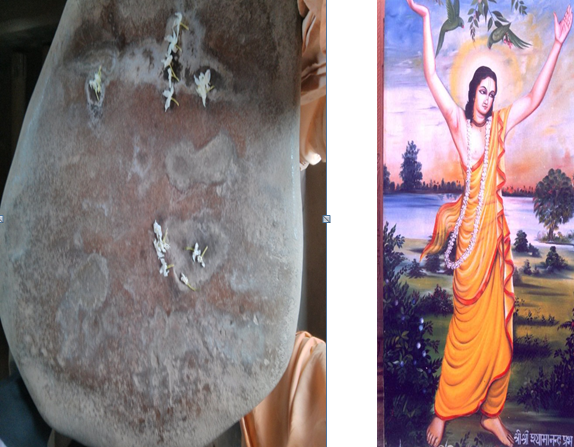
Below are the footprints of both Shyamananda pandit and Rasikananda.
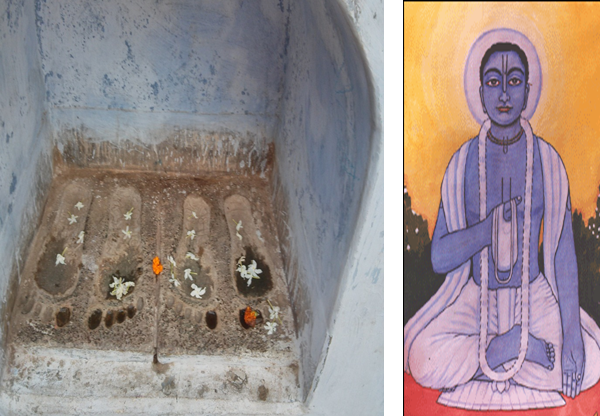
River Suvarnarekha flows through the village of Gopivallabhpur.
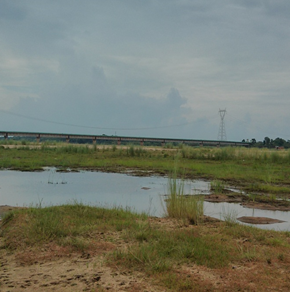
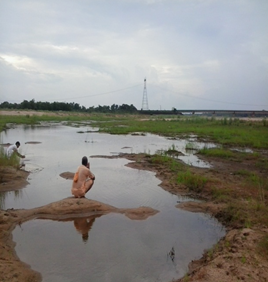
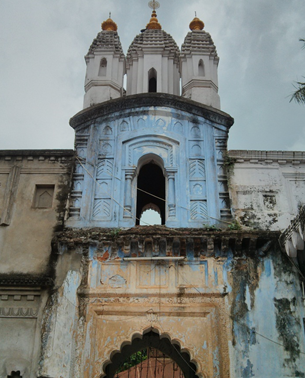

For forty years, Rasik preached on behalf of Shyamananda, and often they went on preaching tours together. The standard biographies, such as Rasik Mangal and Shyamananda Prakash, tell how they put an end to animal sacrifices in non-Vaishnava areas and convinced people throughout Orissa and its bordering villages of the validity of Mahaprabhu’s message.
Shyamananda converted the famous landlord of Ghatshila, Bhimadhana Bhuiyan, the landlord of Govindapur, Uddanda Roy, Rajyadhar Roy, and many others; Rasik was responsible for the Vaishnavism of Baidyanath Bhanja, ruler of Mayurbhanj, the king of Patashpur, Harinarayana of Panchet, Chandrabhanu, king of Mayna. Thousands of others followed them as they followed Rasik and Shyamananda. Gopiballabhpur became the religious center for all of these people. Dharanda Shri Shyamananda Prabhu was born in Utkala in a family of milkmen, in a place called Dharenda Bhadura Pur (presently known as Kalaikunda in Midnapur dist of West Bengal – close to Kharaghpur railway station)
. 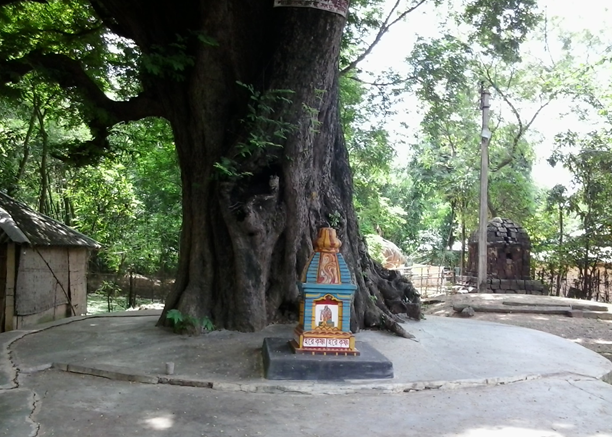
Above is the image of the tree under which Shyamananda prabhu took birth.
His father’s name was Shri Krishna Mandal. His mother’s name was Shri Durika. Shri Krishna Mandal, who was in the dynasty of the Six Gopas, had sired many sons and daughters who had passed away before this son took his birth. Because of the great misfortune which had befallen his family, Shri Krishna Mandal named the boy Dukhi. Everyone said that the boy would become a great person, a Mahapurush. On an auspicious moment on the full moon day of the month of Caitra, he appeared within this world by the mercy of Lord Jagannatha. Because he had come to preach the glories of Jagannatha, the Lord Himself protected him as he grew up. The boy was so beautiful he was like cupid himself; all eyes were fixed upon him. Gradually it was time for the child’s “grain-eating ceremony” (that time at which a child is first offered solid food.), and soon after that he began going to school. Seeing his amazing brain, the scholars were astonished. In a short time, the boy learned Sanskrit grammar, poetry, and rhetoric. And soon after this, he began seriously studying the scriptures. Upon hearing the glories of Sri Caitanya and Nityananda from the mouths of the local devotees, the boy developed anintense desire to take shelter at his lotus feet. His father, Shri Krishna Mandala, was a great devotee of Krishna. Seeing his son always engrossed in thoughts of Gaura-Nityananda, he told him to take mantra initiation. The boy said, “Hriday Caitanya Prabhu is my guru, he lives in Ambika Kalna. His guru is Gauridas Pandit. Those two great brothers, Shri Gaura and Nityananda always reside in his home. If you give the order, I will go to him and become his disciples.
Shri Krishna Mandal said, “My boy! That is a long way away! How will you get there?”
Dukhi said, “Father, many people from here will soon go to Gauda-desh to bathe in the Ganges. When they go, I will go with them.”
For a long time, his father thought this over, and finally gave his permission. After receiving the blessings of his father and mother he began his journey to Gaudadesh. Gradually he came to Nabadwip and Shantipur, and finally arrived in Ambika Kalna.
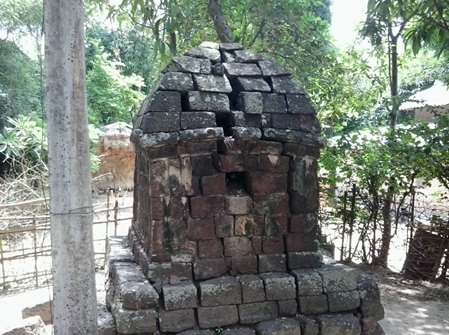
Above is the image of Samadhi of Shyamananda prabhu’s mother Durika devi.